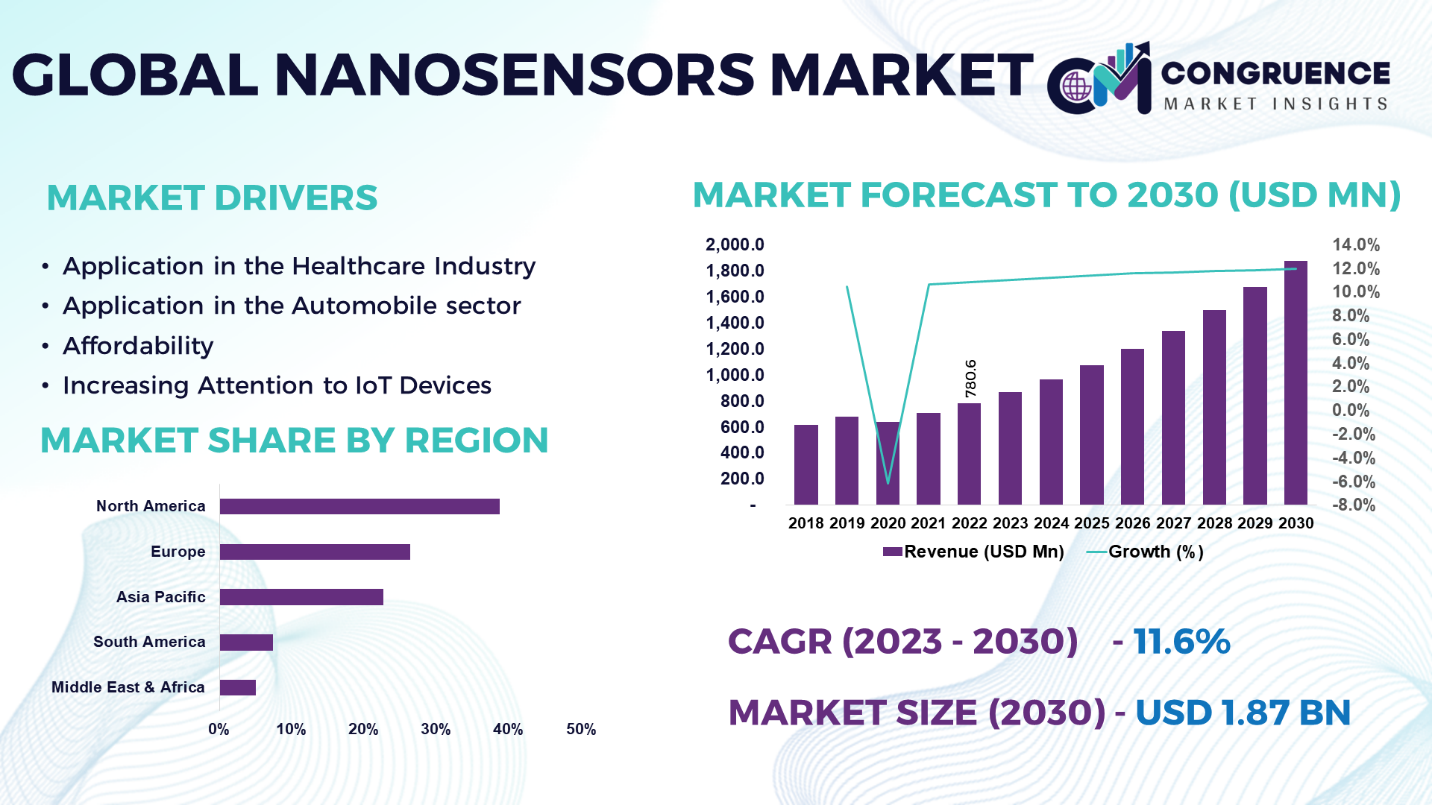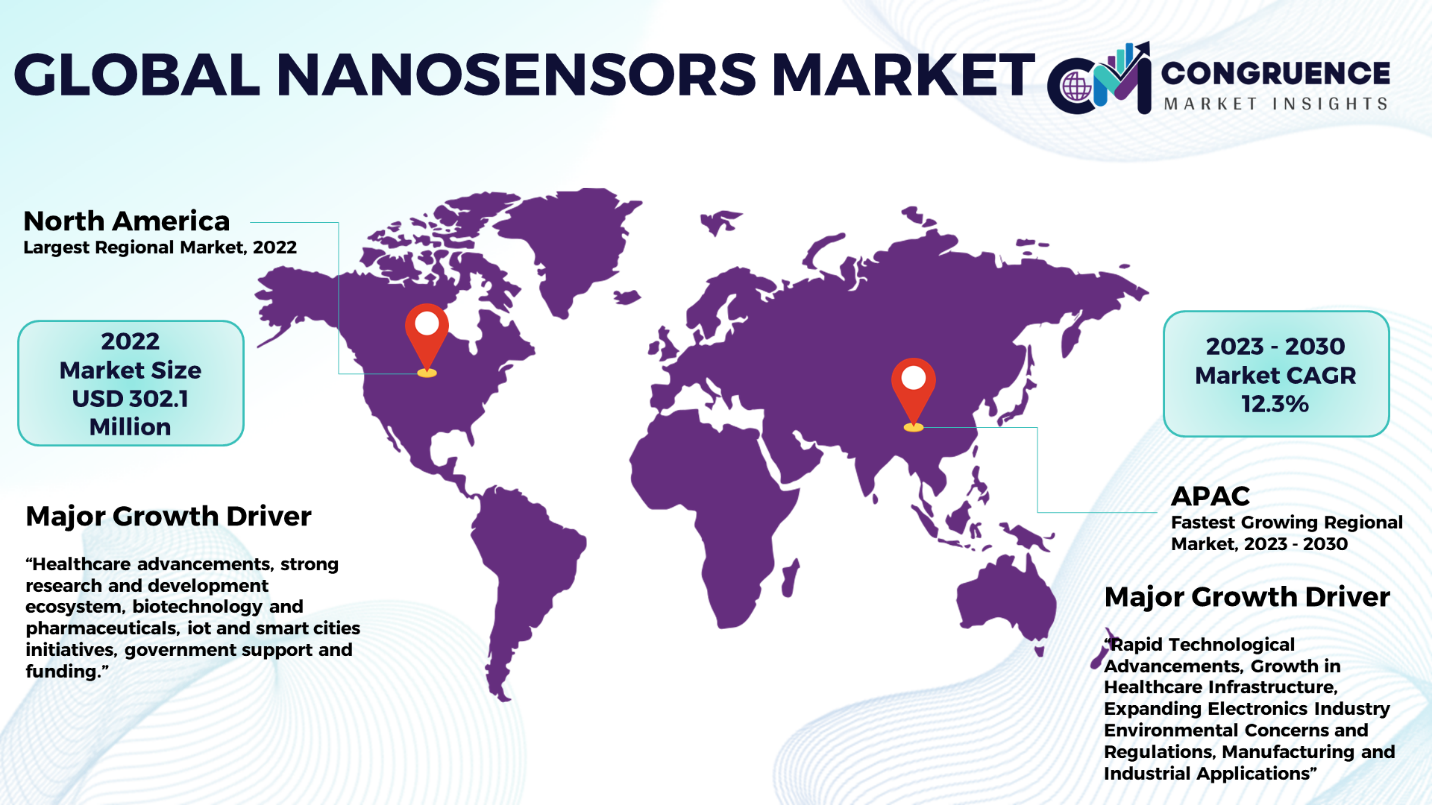Reports
Nanosensors Market Size and Forecast 2023 to 2030
The Global Nanosensors Market was valued at USD 780.6 Million in 2022 and is anticipated to reach a value of USD 1,871.0 Million by 2030 expanding at a CAGR of 11.6% between 2023 and 2030.

To learn more about this report, request a free sample copy
A nanosensor is a device that can transmit data and information from the nanoscale level to the macroscopic level concerning the properties and behavior of particles. Nanosensors can be used to measure physical factors such as temperature at the nanoscale or to detect chemical or mechanical information such the existence of chemical species and nanoparticles. The construction and use of nanosensors allow for different classifications. Nanosensors can be classified into two categories based on their structural differences: optical and electrochemical. The nanosensor can be classified as a chemical nanosensor, biosensor, electrometer, or deployable nanosensor depending on its intended use. The chemical, optical, medicinal, food, and electronics industries can all benefit greatly from the use of nanosensors. Nanosensors in particular have exciting uses in the detection of pollutants, food and water quality, and medical diagnostics. Among the many applications of nanosensors, optical signal detection is one of the most promising.
How AI is transforming Nanosensors Market?
AI is transforming the usage of nanosensors in various industries by improving the sensor functionality, sensitivity, and selectivity in terms of their application. The real-time data processing capacity of nanosensors can be enhanced due to the design of new AI algorithms. This leads to better control in fields such as health monitoring, environmental and process monitoring and control.
AI models are also helpful in nanosensor design, in machining better prediction of material characteristics, and better sensitivity. Further, machine learning assists nanosensors in operating independently and make decisions in the specific environment, as well as managing the sensors’ level of maintenance. Such a change increases the pace of ideas being brought to market and the market opportunity in a given domain.
Nanosensors Market Major Driving Forces
· Application in the Healthcare Industry: The market is anticipated to be driven by current developments in the medical field and the rising demand for sophisticated healthcare. The market is anticipated to be driven primarily by technological advancements and upgrades that improve nanosensors' capabilities and shorten the average time needed for diagnosis and detection. Its capacity to interact at the molecular level with tissues and cells is a major driver of market expansion.
· Application in the Automobile sector: The automobile sector makes considerable use of nanosensors. Nanosensors are utilized in the automotive and transportation industries to increase ergonomics, redundancy, and fuel efficiency in both cars and aircraft. Consequently, the car will use less petrol.
· Affordability: Over the next few years, demand is anticipated to be supplemented by the growing affordability of nanosensors as a result of the growing need for high-quality, economically viable goods in emerging regions.
· Increasing Attention to IoT Devices: The incorporation of nanosensors into IoT technologies is becoming more and more common. Nanosensors are essential sources of data for Internet of Things systems, facilitating automation, real-time monitoring, and predictive analytics. The combination of IoT with nanosensors creates a wealth of new and exciting options for growth and innovation.
Nanosensors Market Key Opportunities
· Emerging Applications in Energy Management: The discipline of energy management has a great deal of promise for using nanosensors. They can be applied to energy system defect or inefficiency detection, energy distribution network optimization, and energy consumption monitoring. The effective collecting and storage of energy can be made possible by the integration of nanosensors with renewable energy sources.
· Developments in Biomedical Sensing: There are a lot of prospects for nanosensor applications in the healthcare sector. The goal of ongoing biomedical sensing research is to create nanosensors with high levels of precision in the detection and analysis of infections, physiological factors, and biomarkers. Personalized medicine, medication development, and disease diagnostics could all be transformed by these developments.
· Adoption in Manufacturing and Industrial Automation: Nanosensors are essential to manufacturing and industrial automation operations. They make quality assurance, predictive maintenance, and real-time equipment performance monitoring possible. Industries can increase overall operational efficiency, decrease downtime, and boost production by incorporating nanosensors into manufacturing systems.
Nanosensors Market Key Trends
· A developing trend in IoT technology is the incorporation of nanosensors. The creation of intelligent decision-making, data interchange, and seamless networking are made possible by this combination, which promotes the creation of smart systems and applications.
· The use of nanosensors for environmental sustainability and monitoring is becoming more and more important as environmental concerns develop. Environmental management is aided by nanosensors, which offer real-time data on climate change, water pollution, and air quality.
· Wearable technology is becoming more and more popular, including smartwatches and fitness trackers. These gadgets' many functions, including as activity tracking, environmental sensing, and biometric monitoring, are made possible in large part by nanosensors.
· Nanosensors are being utilized more and more in the medical field for delivering medications, evaluation, and diagnosis, which helps to provide point-of-care and customized solutions.
· Increasingly sophisticated and effective nanosensors are being produced as a result of ongoing advancements in nanotechnology and fabrication methods.
Region-wise Market Insights
North America accounted for the largest market share at 38.7% in 2022 whereas, Asia Pacific is expected to register the fastest growth, expanding at a CAGR of 12.3% between 2023 and 2030.

To learn more about this report, request a free sample copy
Geographically, North America is anticipated to lead the world market for nanosensors with highest market share of 38.7%, accounting USD 302.1 million. This is due to the large number of major industry participants located there. The United States' rise to prominence as one of the world's most technologically advanced countries is defined by its technological past.
· American corporations such as Agilent Technologies, Inc., Honeywell International Inc., Texas Instruments, and many more are developing novel nanosensor technologies to improve their cash flow.
· According to the U.S. Department of Agriculture, International Space University researchers have developed a sensor that can detect organophosphates at 40 times smaller concentrations through the use of nanotechnology. As a result, there is a huge need for nanosensors in this area, which is driving up the demand for them in North America.
The market for nanosensors is anticipated to expand magnificently in the Asia Pacific region, exhibiting a robust compound annual growth rate of 12.3%. This region's worldwide nanosensors market is increasing more quickly owing to the rising need for effective disease diagnosis methodologies and the increasing application of nanosensors across a number of end-user sectors. Since they are more sensitive and versatile compared to conventional sensors, nanosensors are crucial to the medication of diabetes. As a result, the Asia Pacific nanosensors market is expanding rapidly due to this reason.
Recent Market Developments
· In February 2024, Texas Instruments (TI) launched two new power conversion device portfolios to enhance power density at lower costs for nanosensors
· In January 2024, MIT announced that it has developed a technology that uses inhaled nanoparticle sensors to detect lung cancer. The sensors interact with cancer-linked proteins and produce a signal detectable in urine, using a simple paper test strip.
· In December 2023, Agilent Technologies announced partnerships to expand their nanosensor technologies for applications in chemical manufacturing and healthcare
· In October 2023, Honeywell International integrated advanced nanosensors into aerospace systems to improve safety and performance
Market Competition Landscape
One of the main characteristics of the global nanosensors market is the intense competition among several players. Important firms in the nanosensors industry use tactics to get an advantage over their rivals. In order to adapt to changing consumer tastes, these methods include product innovation, design distinction, and the use of eco-friendly and sustainable materials. Established companies rely on their quality and dependability reputation to hold onto market share, while more recent competitors concentrate on disruptive technologies and USPs.
Prominent players in the market include:
· Nanosensors, Inc.
· Applied Nanotech Holdings, Inc.
· Nanomix
· Nanowear
· Nanocomp Technologies
· Nanosurf AG
· Owlstone Nanotech
· Sensirion
· Cambrios Advanced Materials
· QD Vision
· Analog Devices, Inc.
· Bruker Nano Surfaces
· Nanogen
· Nanosys
· Nanospective
Nanosensors Inc., works in the field of nanotechnology, with a focus on healthcare, environmental monitoring, defense electronics manufacturing, process control equipment and energy. Applied Nanotech is a focusing its business around medical diagnostics testing technology based on nano sensor-array technologies Nanowear's emphasis lies in wearable nanosensor technologies for remote patient monitoring and chronic disease management.
Emerging Startups in the Global Nanosensors Market
· Nanowear: Nanowear is one of the existing startups involved in the nanosensor industry majoring in textile nanosensor systems. Founded in 2014 in New York, the company has created a platform called SimpleSENSE™, the wearable diagnostic device that contains nanosensors for biometrics data gathering. Here we show potential for utilizing this platform in real-time, non-invasive home monitoring applications in patients with chronic diseases particularly cardiovascular conditions. Established through nanosensors incorporated into fabric, Nanowear’s device identifies the physical characteristics of a patient, including pulse, respiration, and skin conductivity.
The startup has received enormous attention because of the revolutionary technology in the medical field. Incorporation of nanosensors together with an artificial intelligence-based system analysis, the collected data is relayed to the healthcare providers for the constant remote monitoring. This in turn leads to an improved early diagnosing and subsequent individualized management of patients. The fact that FDA has approved Nanowear and other collaborations, the company is creditably positioning itself to initiating nanosensors into wearable health monitoring systems.
· GraphWear Technologies: GraphWear Technologies Inc. is a San Francisco based startup founded in 2015 focused on noninvasive health monitoring systems built from graphene-based nanosensors. The company’s most well-known product is a wrist-worn gadget that tracks glucose level, eliminating the requirements of using a needle and a drop of blood. However, it uses graphene nanosensors which are used to analyze glucose content present in sweat rather than causing the patient to undergo invasive procedures like pricking his/her finger to check for diabetic symptoms.
This results from GraphWear’s utilization of high sensitivity and the conductivity of graphene to track small biochemical signals and accurately monitor health in real-time. It is interested in launching multiple products related to other aspects of one’s health, including the hydration and electrolyte status of the body, in both athletes and chronic disease sufferers. The technology at GraphWear, is paving the way for the future, where patients can freely monitor their health without invasive interventions.
|
Report Attribute/Metric |
Details |
|
Market Revenue in 2022 |
USD 780.6 Million |
|
Market Revenue in 2030 |
USD 1,871.0 Million |
|
CAGR (2023 – 2030) |
11.6% |
|
Base Year |
2022 |
|
Forecast Period |
2023 – 2030 |
|
Historical Data |
2018 to 2022 |
|
Forecast Unit |
Value (US$ Mn) |
|
Key Report Deliverable |
Revenue Forecast, Growth Trends, Market Dynamics, Segmental Overview, Regional and Country-wise Analysis, Competition Landscape |
|
Segments Covered |
· By Type (Optical Nano Sensor, Chemical Nano Sensor, Physical Nano Sensor, Biosensor, and Others). · By Technology (Wind Turbines, Fuel Cells, Micro Turbines). · By Application (Electronics, Energy, Chemical Manufacturing, Aerospace and Defence, Healthcare, and Others). |
|
Geographies Covered |
North America: U.S., Canada and Mexico Europe: Germany, France, U.K., Italy, Spain, and Rest of Europe Asia Pacific: China, India, Japan, South Korea, Southeast Asia, and Rest of Asia Pacific South America: Brazil, Argentina, and Rest of Latin America Middle East & Africa: GCC Countries, South Africa, and Rest of Middle East & Africa |
|
Key Players Analyzed |
Nanosensors, Inc., Applied Nanotech Holdings, Inc., Nanomix, Nanowear, Nanocomp Technologies, Nanosurf AG, Owlstone Nanotech, Sensirion, Cambrios Advanced Materials, QD Vision, Analog Devices, Inc., Bruker Nano Surfaces, Nanogen, Nanosys, Nanospective. |
|
Customization & Pricing |
Available on Request (10% Customization is Free) |
